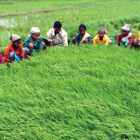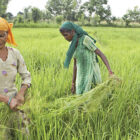India needs to weather the WTO storm with diligent data collection, research, documentation and superior negotiation skills.
India seems relieved having convinced the United States to advocate on its behalf at the WTO on issues arising from its food security programmes, as is clear from the draft of the US-India deal on public stockholding for food security. Food-exporting nations are rejoicing at New Delhi signing on the dotted line without insisting on a reduction of farm support in developed countries. As India defends public procurement and stock holding, they will look at opportunities to export high-value produce like fruit, vegetables, milk, poultry and pulses to India.
Food prices have been rising for many years; more so since 2007. As a result, food-importing countries, usually developing nations, are not keen on subsidy reduction in developed countries, because this would increase the cost of their food imports. Now that the trade facilitation agreement is inevitable, the government must insist on the removal of the many unresolved anomalies and ambiguities in the international trade architecture before a final agreement is inked.
Farm support that increases production and skews the market price is considered trade distorting. At the WTO, the market price prevailing in 1986-88 is the “reference price” used for calculating subsidies. Had this reference price been updated — say it was the average price of the preceding three years — India would be in no danger of breaching the WTO subsidy limit of 10 per cent. Logically, it should not bother anyone if India’s support price is less than the prevailing international price. Yet, other rice-exporting nations complain about India’s rice subsidies.
India could also evoke the WTO Agreement on Agriculture, where “due consideration is given to the influence of excessive rates of inflation on the ability of any member to abide by its domestic support commitments”. Inflation over the past 25 years (about 600 per cent) warrants India not being able to abide by domestic support commitments.
India could have weathered the storm at the WTO better but for the lack of diligence in collecting data, research, documentation and negotiation skills. India was also negligent in not notifying its subsidies for 10 years. Ultimately, Indian protestations of innocence were not taken seriously and the country was unable to garner support at the negotiations.
The crux of the matter is how support is quantified. Support can be classified as an amber-box subsidy — considered to be production-and trade-distorting — or as a green-box subsidy, which is non-distortionary. Blue-box subsidies — direct payments under a production-limiting programme — supposed to be interim measures to move away from amber-box subsidies, get to escape adverse quantification and must be discarded. As a farmer, one strongly holds that the value of trade price distortions as a result of support must also be quantified as an amber-box subsidy. The US gives $3 billion worth of support to its 27,000 cotton farmers, who produce 12 per cent of world cotton.
Hypothetically, were this support to be withdrawn, the price of cotton would appreciate by around 25 per cent before stabilising, thereby increasing the value of world cotton output (currently about $55 billion) by $34 billion because of reduced production. This should also be taken into account while calculating US cotton subsidies. In India, seven million farmers produce six million tonnes of cotton worth $12 billion. Each of them could earn an extra Rs 26,000 without adding a single drop of water, fertiliser or sweat to the soil if the US discontinued its support.
India could cautiously emulate Brazil and threaten to take the US to court. The US is going to pay Brazil $300 million to settle claims and continue its subsidies without being hauled to court. Similarly, China directly subsidises cotton farmers by ¥2,800 per quintal. This is over and above the ¥5,900 per quintal that they receive from the market. Indian farmers sell at a minimum support price (MSP) that is less than half this total price.
In India, farm subsidies do not reach over half the intended beneficiaries and need to be redesigned; bottom up. For example, the present system of farm support through MSPs is available for very few crops in select areas of the country. Price support is not available for produce retained for home consumption or to farmers who do not have a marketable surplus because of small land operating sizes. We need income support to be decoupled from production support. The Aadhar ecosystem and Jan Dhan Yojna could be used to implement a system of income support.
Bharat Krishak Samaj has consistently advocated for subsidies that are inversely proportional to land operating sizes, for targeted delivery so that equitable growth can be achieved. First, however, India’s land records need to reflect true land ownership and tenancy rights. Updating land revenue records is up to the states and poses problems that could derail the solution. Only after crossing this bridge can further obstacles be overcome.




